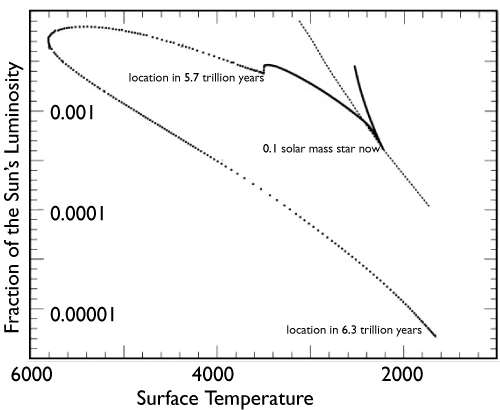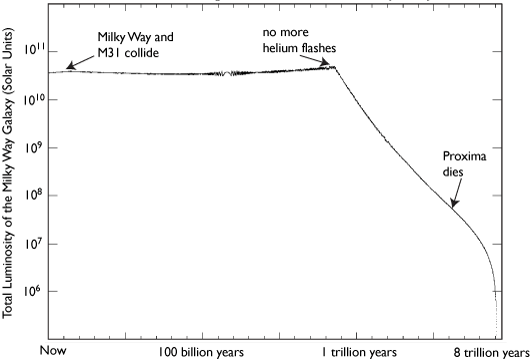
Academics across the United States know the feeling at the end of the long Thanksgiving weekend. Four days were to be given over (at least partially) to catching up with a long list of slipped deadlines and overdue tasks. Like the last line of a haiku, Sunday afternoon arrives.
The red dwarf stars, on the other hand, have mastered the art of having enough time. A trillion years from now, the science of extragalactic astronomy will have long since ended, but Proxima Centauri, our nearest stellar neighbor, will be shining more or less unaltered from its current recessionista persona.

Proxima will never turn into a red giant. Like the other low-mass red dwarfs, it will grow steadily brighter and bluer as it ages, eventually turning itself into a helium white dwarf that gradually cools and fades to black.

The galaxy is filled with red dwarfs, and so as a result, the total luminosity of the Milky Way will stay surprisingly constant for a long time to come. A few years ago, Fred Adams, Genevieve Graves and I wrote a conference proceedings that looks in detail at the future luminosity evolution of the galaxy.
As the Milky Way’s stellar population ages, the more massive stars (The Sun, Sirius, Alpha Cen A and B, Tau Ceti et al.) die off . For hundreds of billions of years, their flagging contributions to the galactic luminosity are very nearly compensated by the increase in luminosity of smaller stars. This state of affairs will persist until about 800 billion years from now, at which time the remaining main sequence stars will all have less than ~30% of the solar mass. These stars never experience the large luminosity increase associated with the red giant phase, and the galactic light curve declines gently for about 7 trillion years as the lowest mass stars slowly die. During this long autumn, the galaxy as a whole should look quite blue, because the light is dominated by stars that have aborted their journey up the red giant branch and grown bluer. Eventually, after about 8 trillion years, even the smallest stars have run out of hydrogen and the night sky finally goes black for the duration.

Just trying to put the arrival of Monday morning in perspective.

So… when do the type Ia supernovae stop?
Do we really know that M31 is going to hit the Milky Way? The galaxy may be blue-shifted, but do we know it’s tangental velocity? Are we sure that M31 won’t just fly past the Milky Way at a distance of several galactic radii?
How sure are astronomers that M31 and The Galaxy will collide?
Occasional Type I supernovae will occur for the next ~10^20 years (!) (as a result of white dwarf collisions).
Simulations of large-scale structure formation indicate that it’s extremely unlikely that M31 has sufficient tangential velocity to be gravitationally unbound from the Milky Way. Galactic encounters are dissipative (kinetic energy of translation goes into heating up stellar orbits) so even if they miss on their next pass, M31 and MW will come together on a 10-15 Gyr from now timescale at the latest.
When does star formation end?
Hi Greg,
interesting point ! From your discussion one other thing comes to mind. Given the evolutionary tracks, namely the increase in luminosity and temperature, and the time scales for red dwarfs the habitable zone should move farther away from the star into a region where the planets are no longer tidally locked. Given the time scale at which they evolve this may make red dwarfs very hospitable places for life bearing planets in the distant future, if not today.
Ok thanks for the info on supernovae.
Also, blue dwarf = sdB star?
It’s true that the red dwarfs may have a significant long-term potential for supporting life-bearing planets.
In our paper from 1997 (Laughlin, Bodenheimer and Adams, ApJ 482,420) we wrote:
A decade later, this seems a little naive. It’s likely that a functioning biosphere requires a geologically active planet to maintain the various long-term chemical and atmospheric cycles. A trillion years from now, terrestrial planets will have lost their interior heat.
There will be cases, however, in which dynamical evolution in the system triggers episodes of tidal heating while the star is stepping up to the plate. On the whole, though, these situations will be rare.
Conventional star formation will draw to a close sometime after the MW-M31 collision (which will trigger an intense period of star formation as the gas is shocked).
The remnant MW-M31 elliptical galaxy will experience X-ray cooling flow that will allow gas to eventually accrete at the galactic center. It’s possible that this gas will trigger a late period of star formation.
Brown-dwarf – Brown-dwarf collisions will generate the occasional formation of new red dwarf stars. For the next ~10^20 years, the MW-M31 elliptical galaxy will always support about 50 main-sequence red dwarfs that formed via this mechanism.
If you’re interested in the ultra-long-term future, check out my book with Fred Adams, The Five Ages of the Universe. (Order it in paperback, new or used, here.) It got a scathing review in the New York Times Book Review, which effectively brought our budding science-popularization careers to a quick end. Copies are available used starting at $3.36, so it makes a good recession-era holiday gift.
“Conventional star formation will draw to a close sometime after the MW-M31 collision (which will trigger an intense period of star formation as the gas is shocked).”
Won’t most of those stars return a substantial fraction of their gas to the ISM at the end of their lives?
The sun should live long enough to weather the collision, but it will probably give back 1/4 to 1/3 of its outer, unburned hydrogen when it checks out 5 billion years from now. Why isn’t that gas available for later star formation?